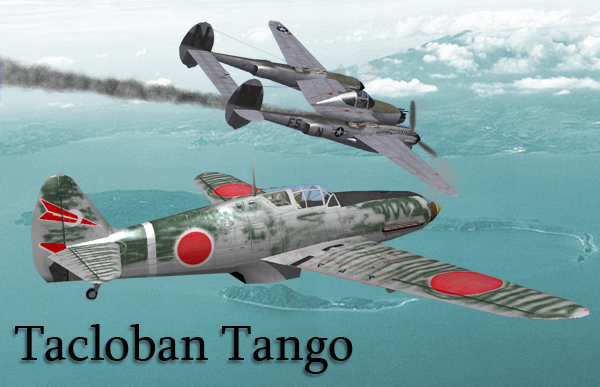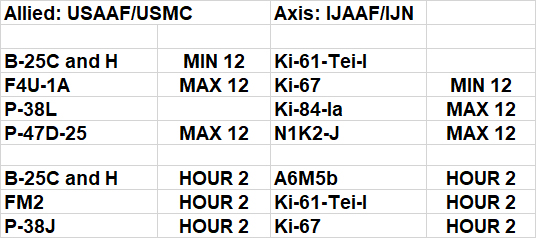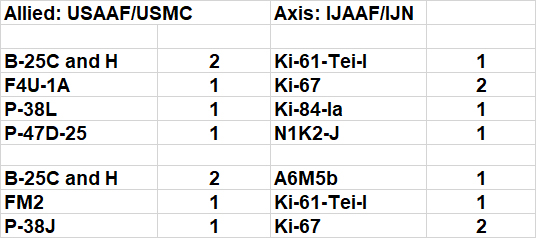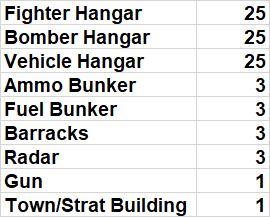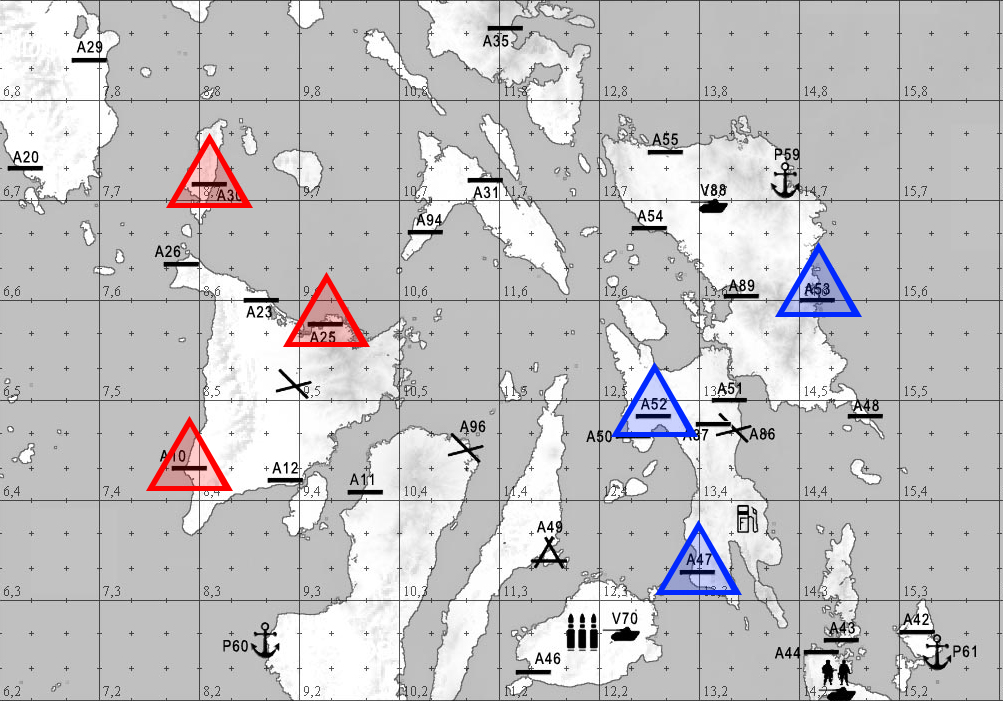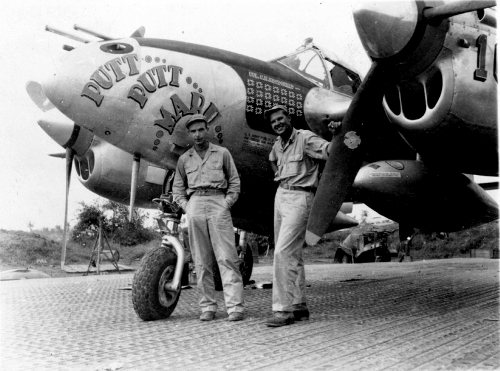After the Solomons operations had concluded, most U.S. Marine aviation remained in and around the Solomons areas, or moved north and operated out of the captured airfields of the Nimitz's thrust through the Central Pacific. Likewise, US Army Air Force resources had been supporting MacArthur's push through New Guinea and into the Phillipines. Neither service had participated in the same scale of joint operations that had characterized the desperate days of the Cactus Air Force on Guadalcanal in late 1942. But, due to poor weather and lack of resources on Leyte, 5th Air Force was not able to move as quickly to operate out of the new fields captured during the landings in late October of 1944.
Meanwhile, off the coast of Leyte, Admiral Kincaid's 7th Fleet was being involved in an on-going air and naval battle that was increasing in intensity. Even after the failed attempt by the Japanese Navy to drive off the invasion force, during the Battle of Leyte Gulf, the Japanese continued to move ships and aircraft throughout the Leyte and Samar island areas to disrupt the allied assault on Leyte, while Kamikaze attacks increased on the ships in San Pedro Bay. Admiral Kincaid began to feel more exposed and pressed 5th Air Force and General MacArthur for more air cover. A compromise was reached, when MacArthur ordered Marine Air Group 12 to move to Tacloban, and begin operations under the command of 5th Air Force.
Ultimately, through December 1944 and January 1945, MAG-12, and eventually MAG-14 participated in the second major joint air campaign of the war as they teamed up with 5th Air Force assets to support both 7th Fleet at sea, and 6th Army on Leyte. This FSO will attempt to recreate the events of December 1944 and January 1945 in the Phillipines.
AIRCRAFT:
- Fighter Cap 20K - Bomber Cap 14K.
- Aircraft with MINIMUM requirements must be flown.
- ALL Fighters Bombs and Rockets Disabled.
- Formations are enabled but not required.
- Pilots may refuel and rearm at ANY FRIENDLY FIELD.
SCORING:
OBJECT SCORING:
HOUR 2 SCORING (SHIPS ONLY)
ACE MISSIONS:
Each side will have one mandatory Ace mission per frame. These frames will represent notable pilots of the time and theater. One pilot from each side will designated an "Ace" Pilot. They will be scored as follows.
Ace Pilot = 20 Points
Ace Pilot Kills = 5 Points
So for example if an Ace Pilot is shot down they are worth 20 points to the other side. Like wise, every victory an Ace Pilot lands they will be rewarded 5 points.
IJN/IJAAF Aces
Frame 1 - Lt Commander Ayao Shirane (IJN) A veteran of the carrier battles of Midway, the Eastern Solomons, and Santa Cruz. In July of 1944 he was given command of the 401st Sqaudron of the Yokosuka Air Group flying the new N1K Shinden (George). In October 1944 he took his squadron to Luzon where they saw immediate action. Shirane was shot down and killed by P-38s from the 433rd FS on November 24th 1944. He had 9 aerial victories.
Frame 2 - Master Seargeant Satoshi Anabuki (IJAAF) Anabuki fought in the 1941 invasion of the Philippines and then in Burma. In October 1943 he shot down three B-24s and 2 P-38 escorts. He downed one of the B-24s by ramming it, wounding himself. He would later ferry Ki-84 fighters from Formosa to the Philippines where he would shoot down 6 F6F Hellcats. He would survive the war claiming 59 victories but was officially credited with 39.
Frame 3 - Chief Petty Officer Shoichi Sugita (IJN) - Sugita saw fierce action in the Solomons and became a leading ace in the campaign and flew in the infamous Yamamoto mission. Sugita was given a chance to redeem his honor and continued to fight on in the Carolines, Marianas and scored numerous kills in the Philippines. Sugita was killed while trying to take off on 15th 1945 in the defense of Japan. He was recognized as having achieved 70 victories.
USAAF/USMC Aces
Frame 1 - Colonel Charles MacDonald (USAAF) - MacDonald arrived in Dobodura, New Guinea in October, 1943 and scored 4 victories that month. He became an ace on November 9th 1943. While commanding the 475th FG in the Philippines he shot down 13 enemy aircraft from Nov 10th 1944 to January 1st 1945. MacDonald would score his final victory March 13th1945, bringing his total score to 27. Charles MacDonald passed away in March, 2003.
Frame 2 - Major William Dinghy Dunham (USAAF) When Dunham was given command of the 460th FS of the 348th FG he had already shot down 9 enemy fighters in the New Guinea area. While in the Philippines Dunham would shoot down 1 Japanese fighter on November 18th and then shoot down 4 in one day on December 7th, 1944. In all, William Dunham would shoot down 16 aircraft during World War 2. He passed away in March, 1990.
Frame 3 - Lt Joel Paris III (USAAF) - Paris flew the P-40 series in New Guinea and later the P-38 in the Philippines for the 7th FS, 49th FG. Credited with 9 victories in total he shot down 5 of them during the last week of December, 1944. He was awarded the Silver Star during the invasion of Mindoro when he shot down two Zero fighters while escorting a PBY floatplane to the island. Paris retired from the USAF as a Major General.
- Luzon terrain
- Icon Range - Friendly 3k, Enemy 3k.
- No Radar
- Fighter and Bomber Warning Range - 63360 (12 miles)
- Tower Range - 63360 (for display to match the above Fighter and Bomber Warning)
- External view for bombers (F3) - On
- Friendly Collisions - Off
- Enemy Collisions - On
- Kill Shooter - Off
- Fuel - 1.0
- Ack - 0.3
- Formations - Enabled
- Bombsite calibration - Main Arena Standard
- Visibility - 17 miles
- Object Downtime full (200)
- Winds - None
- Extreme Downdraft at 20K
Original Design by Stoney 2009
Edited by Nefarious 2012 and 2023
Please take the time to contact your squads and ask what their choice of rides would be.
You can contact all the squads on your side here.
Please note the updated rules.
